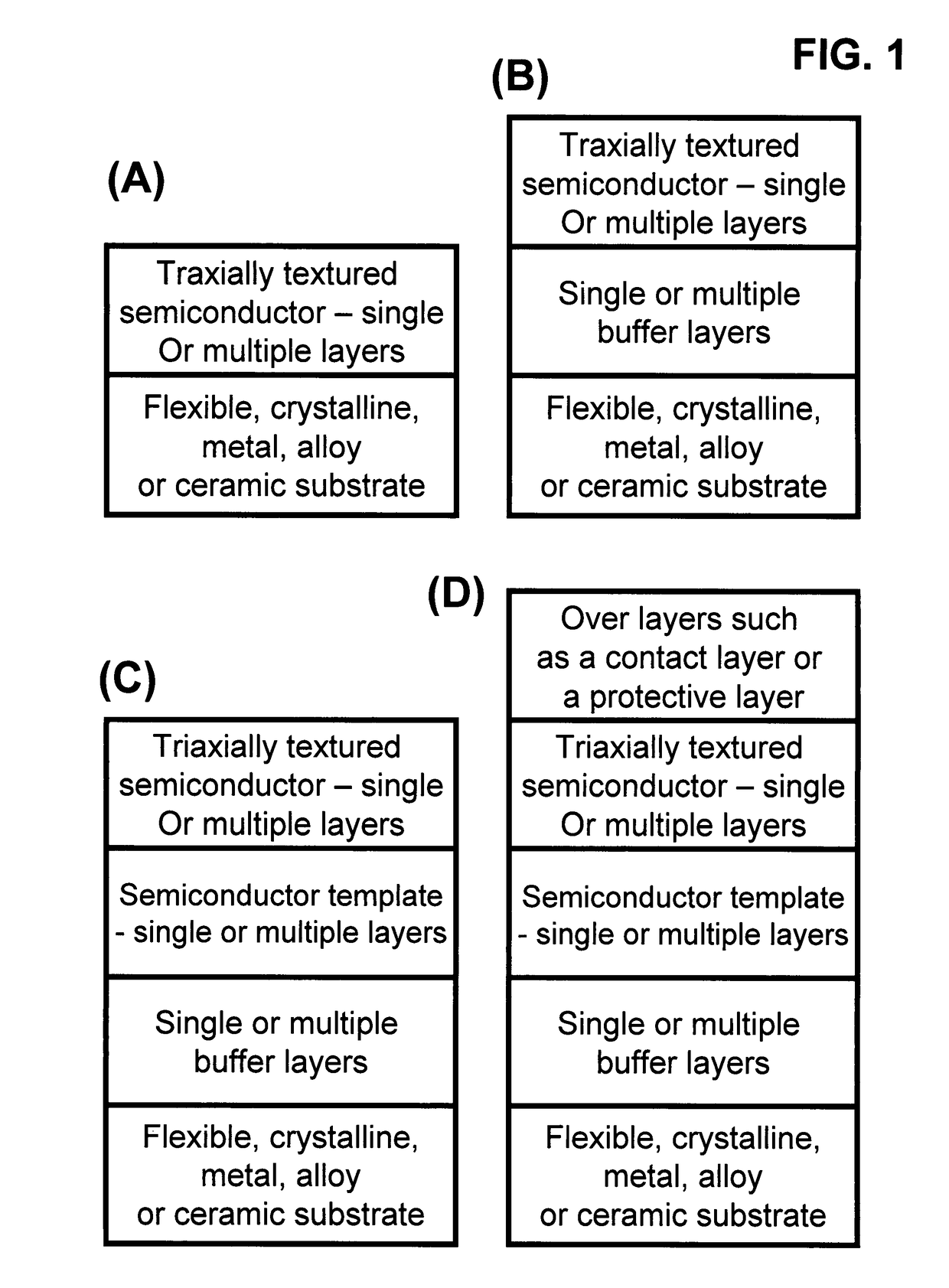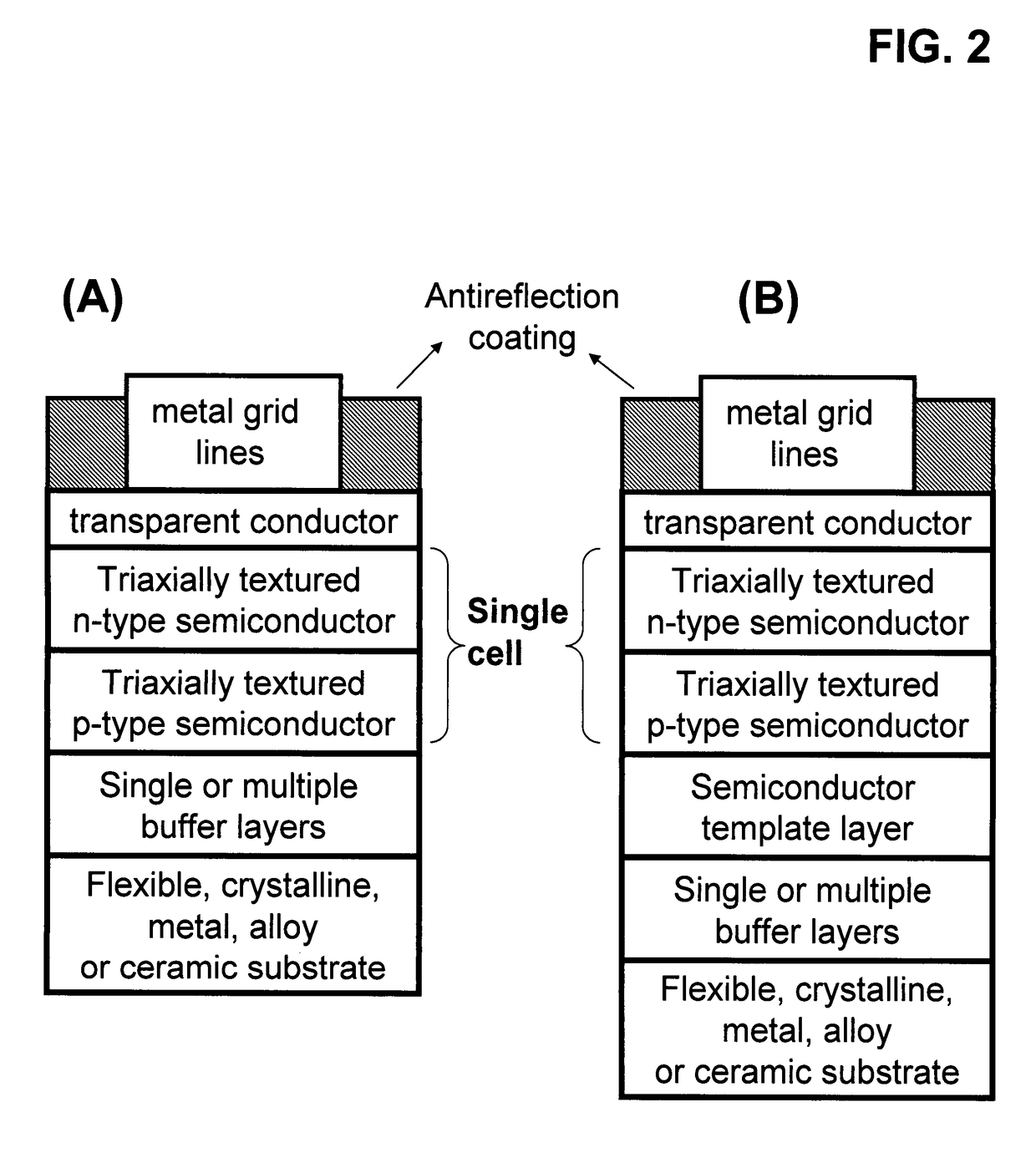Semiconductor-based, large-area, flexible, electronic devices
a technology of semiconductors and electronic devices, applied in the direction of sustainable manufacturing/processing, final product manufacturing, natural mineral layered products, etc., can solve the problems of unrealized solar energy promise, prohibitively expensive cost of single crystal substrates, unfavorable price/performance metric, etc., and achieve good lattice matching
- Summary
- Abstract
- Description
- Claims
- Application Information
AI Technical Summary
Benefits of technology
Problems solved by technology
Method used
Image
Examples
example 1
[0154]Shown in FIG. 14 is an idealized schematic representation in cross-section of a triaxially textured, flexible NiW alloy with a triaxially textured Si semiconductor layer on top of it with an intervening triaxially textured buffer layer of TiN.
[0155]This device is consistent with the devices depicted in FIG. 12. Biaxially textured Ni-3at % W was prepared by successive rolling of a powder metallurgy derived alloy coil from about 120 mils to a foil of about 2 mils or 50 microns in thickness. As-rolled crystallographic texture of the foil or tape was the standard Cu-type rolling texture of heavily deformed FCC metals. After the tape was degreased and dried, it was loaded into a reel-to-reel high vacuum (10−8 Torr) chamber, which contained a radio frequency induction heated furnace. The tape was pulled through the hot zone of the furnace at a rate that heated each part to 1250° C. for twenty minutes with a partial pressure of hydrogen sulfide gas of ˜3×10−7 Torr in order to form a ...
example 2
[0166]Starting with a biaxially textured, Ni-3at % W substrate, a 75 nm thick, epitaxial layer of γ-Al2O3 is grown by electron beam evaporation at a substrate temperature in the range of 700-850° C. This is followed by deposition of an epitaxial Si layer using chemical vapor deposition in the temperature range of 500-900° C. Numerous reports exist in the literature of epitaxial growth of Si on γ-Al2O3 see for example, Liwen tan, Qiyuan Wang, Jun Wang, Yuanhuan Yu, Zhongli Liu and Lanying Lin, “Fabrication of novel double-hetero-epitaxial SOI structure Si / γ-Al2O3 / Si,” Journal of Crystal Growth, vol. 247, pp. 255-260, 2003; K. Sawada, M. Ishida, T. Nakamura and N. Ohtake, “Metalorganic molecular beam epitaxy of films on si at low growth temperatures,” Appl. Phys. Lett., vol. 52, pp. 1672-1674, 1988; M. Shahjahan, Y. Koji, K. Sawada and M. Ishida, “Fabrication of resonance tunnel diode by gamma-Al2O3 / Si multiple heterostructures,” Japn. J. of Appl. Phys. Part 1, vol. 41 (4B), pp. 2602-...
example 3
[0167]Starting with a biaxially textured, Ni-3at % W substrate, a 75 nm thick Y2O3 layer is deposited epitaxially on NiW substrate using electron beam evaporation at a substrate temperature in the range of 300-700° C. This is followed by deposition of a 50 nm thick, epitaxial layer of γ-Al2O3 by electron beam evaporation at a substrate temperature in the range of 700-850° C. This is followed by deposition of an epitaxial Si layer using chemical vapor deposition in the temperature range of 500-900° C.
PUM
| Property | Measurement | Unit |
|---|---|---|
| grain size | aaaaa | aaaaa |
| grain size | aaaaa | aaaaa |
| length | aaaaa | aaaaa |
Abstract
Description
Claims
Application Information
 Login to View More
Login to View More - R&D
- Intellectual Property
- Life Sciences
- Materials
- Tech Scout
- Unparalleled Data Quality
- Higher Quality Content
- 60% Fewer Hallucinations
Browse by: Latest US Patents, China's latest patents, Technical Efficacy Thesaurus, Application Domain, Technology Topic, Popular Technical Reports.
© 2025 PatSnap. All rights reserved.Legal|Privacy policy|Modern Slavery Act Transparency Statement|Sitemap|About US| Contact US: help@patsnap.com



